The Northern Iraqi city of Sinjar has been recaptured from ISIS, but it’s a long way from back to normal.
SINJAR, Iraq—
Atop a hill overlooking this Northern Iraqi town, the head of the Kurdistan Regional Government, President Masoud Barzani, positions himself behind a podium constructed of sandbags. It’s Friday, Nov. 13, and the sky is clear amid a drift of smoke trailing off into the far distance. Over Barzani’s shoulders, the brown streets and rows of houses of Sinjar stretch out over the horizon of the flat landscape. The sandbags are topped with microphones, a thin wire runs to a single, bare speaker.
Fifteen months earlier, the town behind Barzani was ransacked by ISIS fighters in what would become known as the Sinjar Massacre. In the days and weeks that followed, thousands of civilians in the surrounding area from the Yazidi religious minority were systematically killed or sold into sex slavery. Some men were executed individually for resisting and others were beheaded, but the vast majority of the estimated 5,000 killed were lined up and shot en mass. Women and girls as young as six were raped, and with thousands of others, forced into holding camps before being distributed for sale. Those who managed to flee to nearby Sinjar Mountain remained trapped without food or water for weeks. Their plight was cited by Obama as justification for starting the air campaign in which coalition forces and the Iraqi air force dropped supplies and carried out a number of Yazidis. The Kurdistan Worker’s Party (PKK)—the militia fighting the Turkish government for Kurdish independence—later opened a humanitarian corridor to the mountain.
The recapture of Sinjar by Kurdish forces backed by U.S. airstrikes on Nov. 13 was an important strategic victory in the ongoing fight against ISIS. Taking back Sinjar cuts the strategic 75-mile-long Highway 47, the main supply line between the two largest ISIS strongholds of Mosul, Iraq and Raqqa, Syria, isolating the two cities and making the transport of weapons, fighters, and oil between them much more difficult. Recapturing the predominantly Yazidi town was also an important symbolic victory after the Peshmerga’s failure to protect the city from ISIS the year prior, as well as proving that Kurdish forces can fight for ethnic groups other than themselves. But the victory has also raised new political tensions between the Kurdish government, which seeks eventual independence, and the Shiite-dominated Iraqi central government. The politicians in Baghdad want Sinjar to return to their control, as it was before ISIS conquered it, while Kurdish officials say it should become part of Kurdistan.
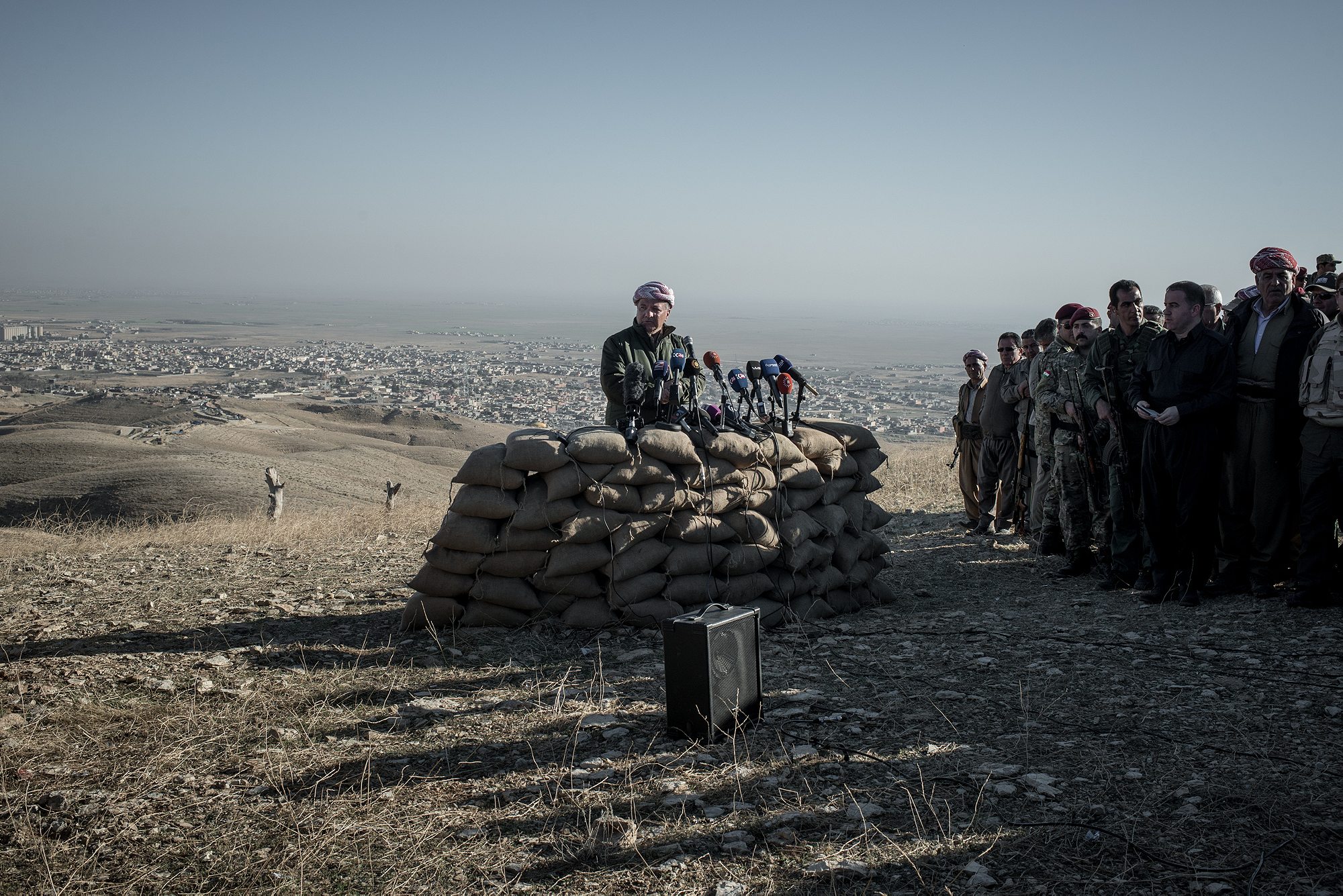
“We delivered on our pledge to liberate Sinjar,” declares a triumphant Barzani in Kurdish from the podium. Troops of neatly dressed soldiers look on, while reporters bustle for photos under the bright midday sun. Barzani thanks the United States for its help in the liberation and goes on to assert that the civilians who helped ISIS take the city would be treated the same harsh and unforgiving way as ISIS fighters themselves. Then, unceremoniously exiting the press conference via a caravan of SUVs, Barzani is gone.
The press conference is over. My driver gets back into our SUV and we descend through the tan foothills of Sinjar Mountain and down to the edge of the city. The dust from the road sweeps up and crashes in waves around us. Scattered Kurdish forces wave us through the cluttered roadway until we finally come to a traffic jam at the entrance of Sinjar. A long line of trucks and cars, mostly filled with heavily armed men awaiting entrance to the city, stretches back along the dirt and rubble. Secondary reinforcements and civilians, I assume, who are entering the city to further bolster defenses, loot, and examine the damage. My two colleagues and I decide that if we are to spend any time in the city before nightfall, we best move forward. Quickly stuffing a few camera essentials in my pockets and strapping on Kevlar, I leave my car with the driver and proceed into the city on foot.
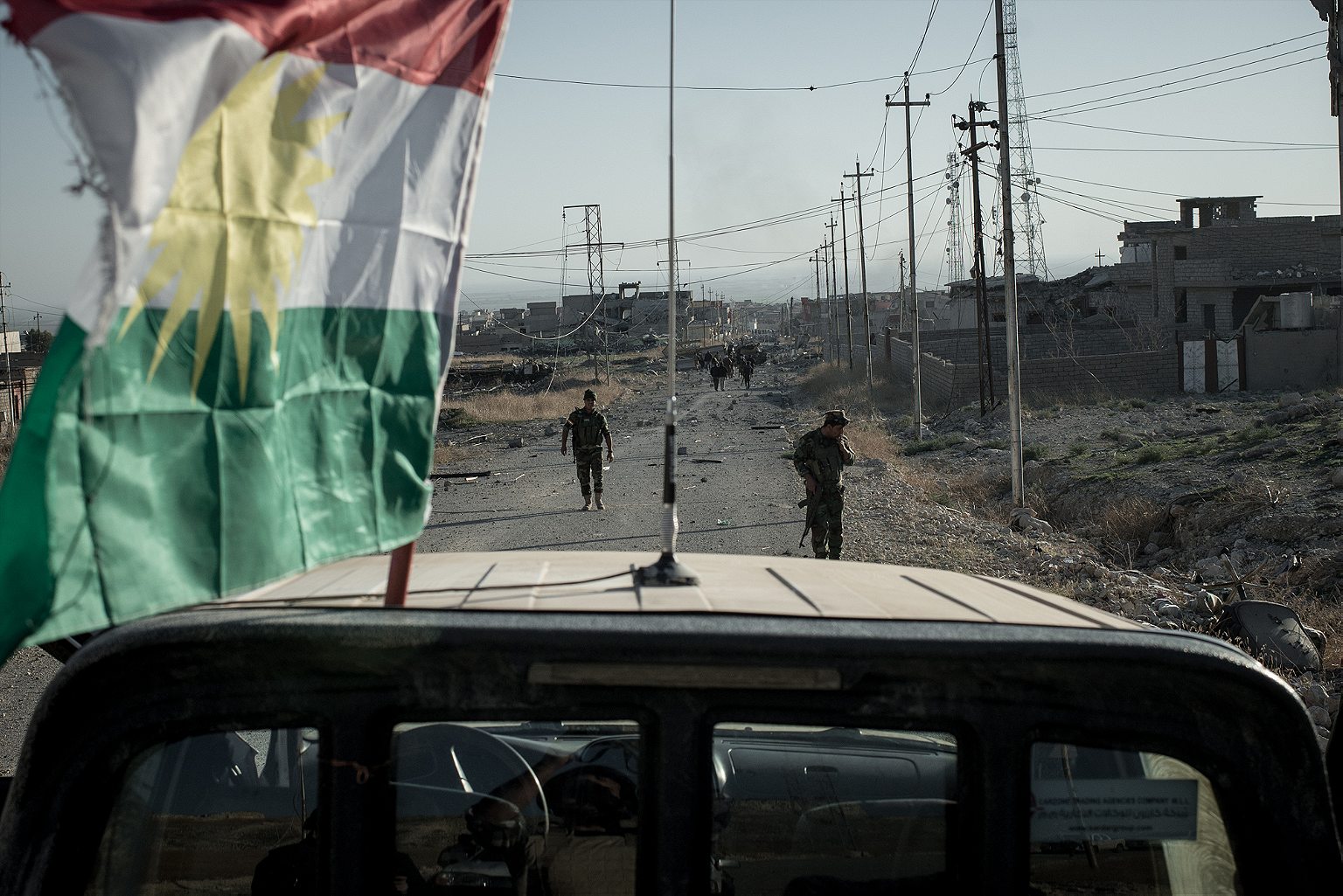
ISIS’s barbarity has become its hallmark, and its guerrilla tactics are well known to its enemies here. In previous cities recaptured from the grip of ISIS, like Kobani and Tikrit, improvised explosive devices and booby traps awaited civilians and rival forces alike upon their arrival in reclaimed territory. What hides behind doors, up staircases, or at the end of unseen wires laced across streets could be the instantaneous or painfully prolonged end of one’s life. ISIS is also known for leaving behind lone-wolf fighters, who aim to hold out until the very end and take out as many individuals as they can before being overrun. These tactics race through my mind as we navigate the backhoes and construction vehicles clearing the last roadblocks.
The blanketing silence of Sinjar strikes me first. An overwhelming calm contrasted with the rubble-strewn, devastated street leading into the city center. The only sounds come from our boots skittering along the ground, crunching debris underfoot. I step over telephone and electrical cables that crisscross the street like some chaotic spider web. In the distance, thin wisps of black smoke linger in the sky.
We continue walking, unguided, into the former ISIS stronghold. As we reach the first intersection, the distinct crack of a single bullet shatters the air around us. There is clearly a sniper still hiding somewhere in the city. We pause for a minute, briefly ducking in the middle of the street behind a burnt-out tanker. Assuming it was a random shot aimed elsewhere, we decide to continue on.
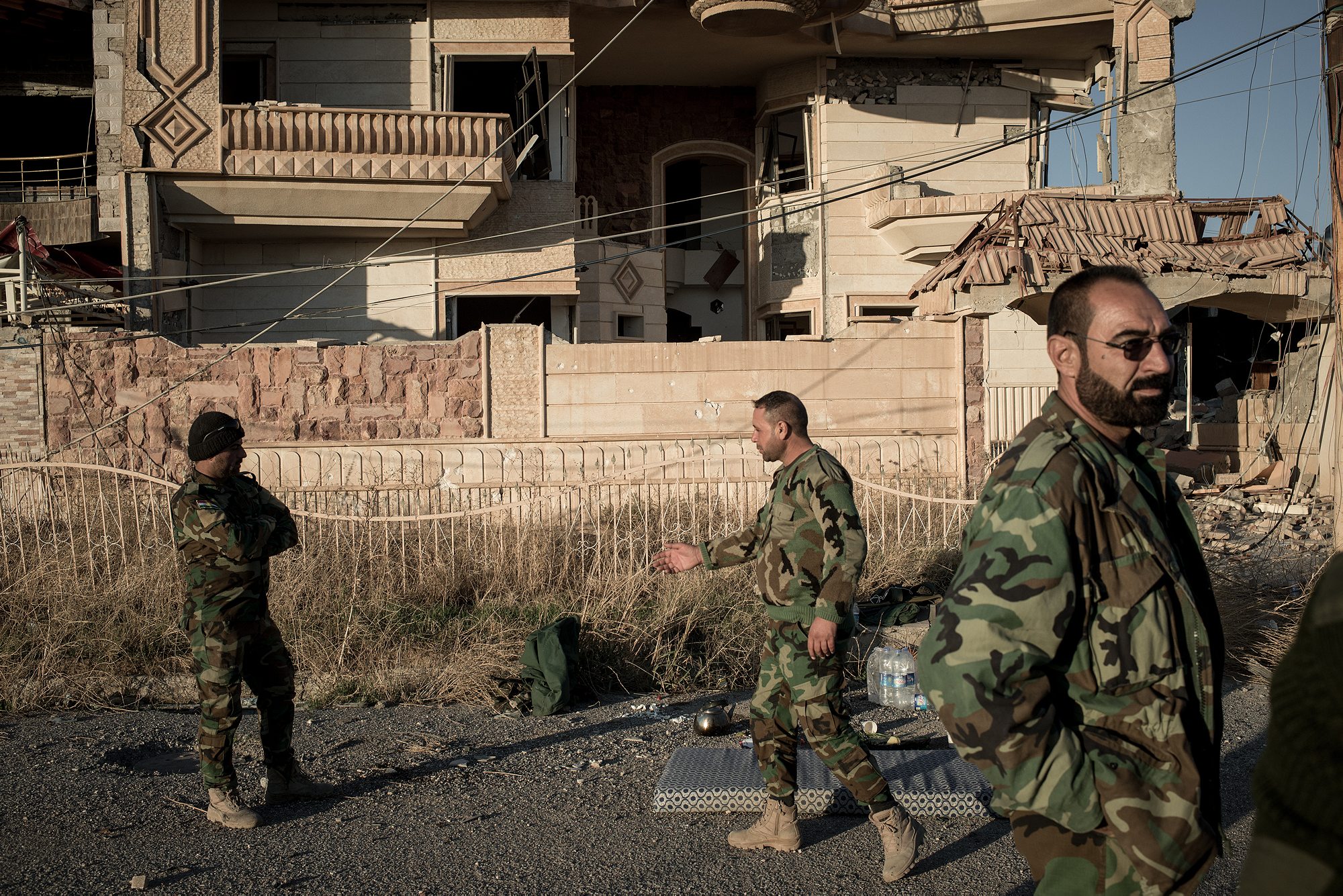
Sinjar, until the invasion of ISIS, was home to the largest and oldest Yazidi community in the world. Their presence in the region dates back centuries, with holy shrines and pilgrimage sites clustered around this city, and into Kurdish-controlled Dohuk. The often misunderstood Yazidi religion incorporates aspects of Zoroastrianism but is also in many ways similar to both Sunni and Shia Islam. It is based on the belief that one god created Earth and gave ownership of the planet to seven angels led by the peacock angel Melek Taus. There are comparisons between Melek Taus and the Quranic Shaytan, or the Satan of the bible. For this reason, many Muslims consider Yazidis devil worshippers. ISIS considers them infidels and the group’s specific targeting of Yazidi communities has led many to accuse it of an ethnic cleansing campaign aimed to resettle formerly Yazidi communities with ISIS-supporting Sunni populations.
Following the recapture of Sinjar, at least two mass graves were discovered on the outskirts of the city. One of the graves is believed to contain the remains of 80 women over the age of 40. Witnesses says ISIS killed the women for being too old to use as slaves. Local officials expect to find more mass graves spread across the region over the coming weeks and months.
As we push further into Sinjar, it becomes evident how much the city suffered since ISIS captured it a year ago. Black spray-painted ISIS graffiti litters walls and buildings, reading “There is no god but Allah. Mohammad is the messenger of Allah.” Intense block-by-block fighting left bullet holes on almost every visible surface. The lingering sulphuric smell of cordite from recent combat mixes seamlessly with the burned-out shells of trucks, tankers, and cars that choke the roads. The city was for the most part an active war zone in the time between the ISIS advance and the Kurdish recapture.
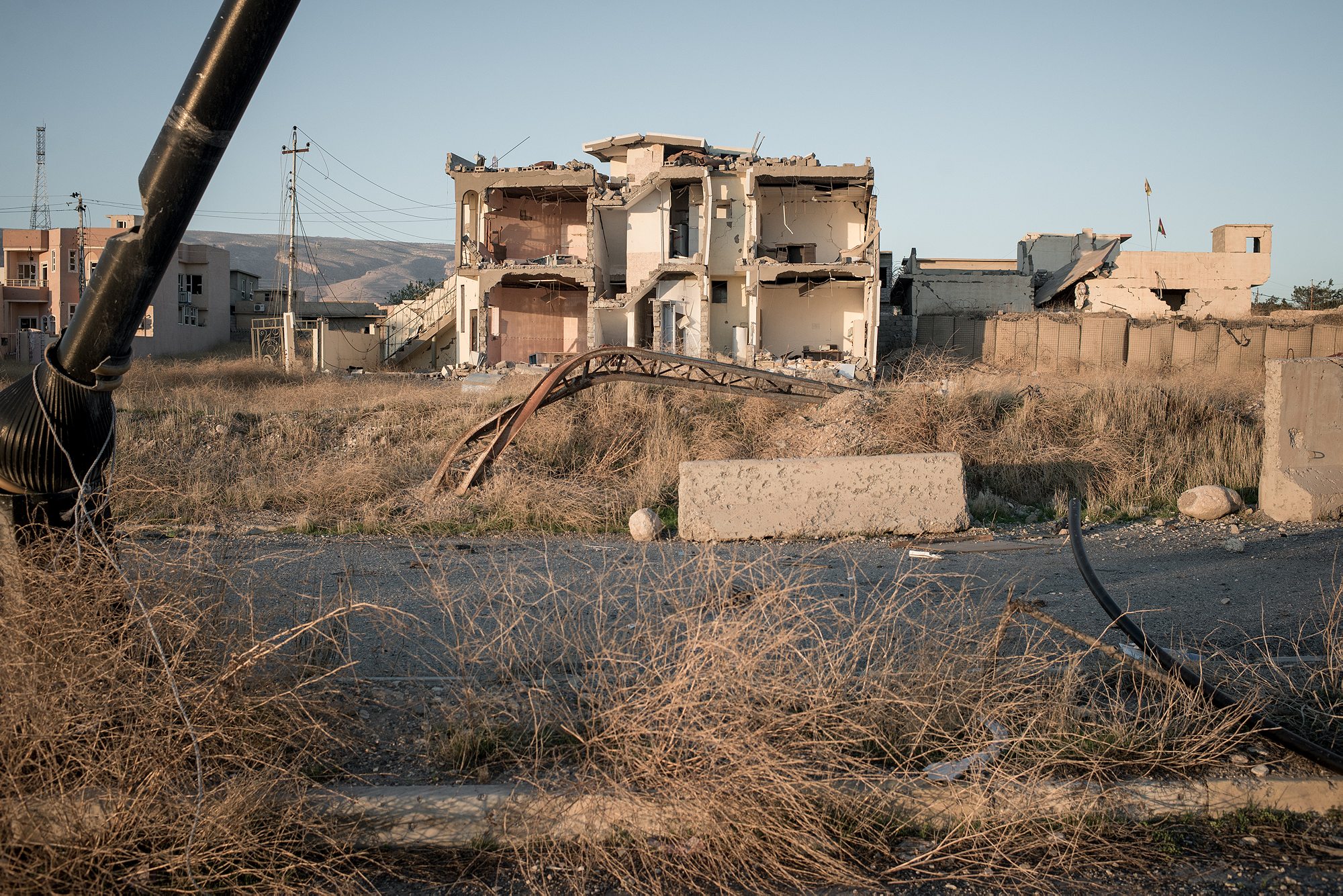
One out of every four houses or buildings in Sinjar is flattened, a result of the U.S.-led coalition airstrikes that helped the Kurds take back the city over the past few weeks. The majority of the buildings that remain standing have serious structural damage, and while roughly one-quarter of Sinjar could be inhabitable with minor construction efforts in the coming weeks, the rebuilding is far from certain.
I pass handfuls of civilians wandering through the streets, apparently unconcerned by the still active danger. It’s the first time they’ve been able to enter their city since fleeing so long ago. Two men point out their house. It sits, half destroyed, with a Kurdish soldier waving his weapon in the air next to a flapping Kurdish flag on the roof. The fighter yells, joyously celebrating the re-capture of Sinjar. The two men hang their heads and walk away.
Every few blocks, groups of armed men mill about in courtyards of the city. Some wearing plain olive-green drabs, others in multicolored camouflage, with weathered but youthful faces, the soldiers look up as I shuffle past. Many ask for a photo or simply jump in front of my camera, posing. Others smile. A few glare. At the mountain press conference, President Barzani gave credit for the victory to the Peshmerga—the military forces of Iraqi Kurdistan— without mentioning any other Kurdish factions. In reality the Peshmerga were heavily assisted by the PKK, Yazidi YBS (Sinjar Resistance Units) militia, and the U.S.-backed Syrian Kurdish rebel group, YPG (People’s Protection Units).
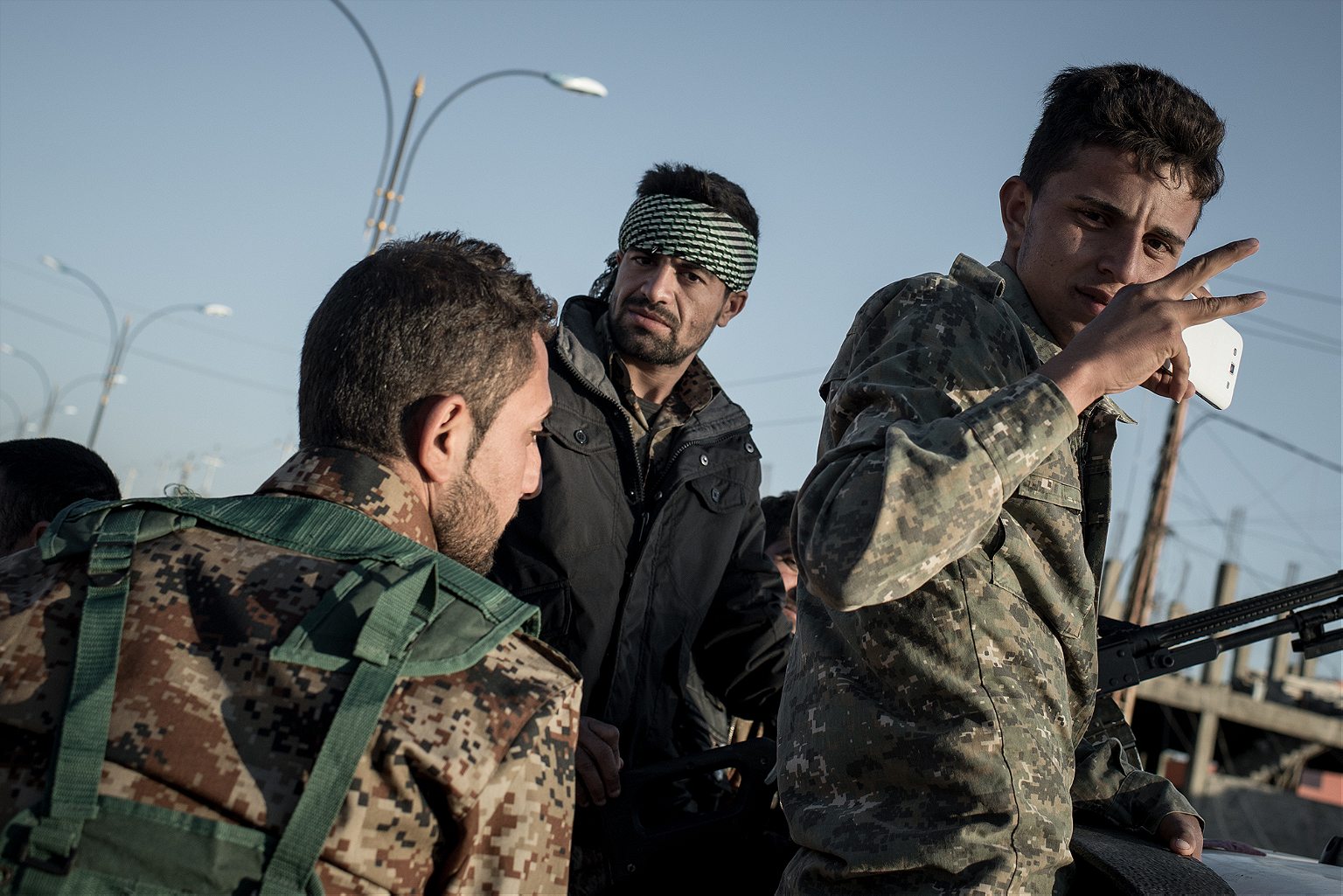
I venture into a house with a group of Yazidi fighters. Broken glass cracks under my feet as I follow a camo-wearing man up a beautiful granite staircase covered with broken pieces of ceramic tile and wires. Reaching the roof I look out as an orange hue spreads out over what remains of Sinjar. Gunfire erupts in the distance and car horns blast, their sounds bouncing down the vacant streets.
On another rooftop nearby I watch a local Yazidi fighter say his late-evening prayers, finally back in the city where he once lived. A few others kick a soccer ball around until it flies off the roof just above where their weapons rest. These feel like some of the first moments of human joy and relaxed interaction the city has seen in a long time.

Cities all over the world from Dresden to Beirut have come together after massive destruction and rebuilt. But it remains to be seen if the people of Sinjar will be able to do so amid the fear, ongoing Kurdish and Iraqi political infighting, and with so few resources. ISIS’s black flags still wave a few miles down the road and there is no guarantee they won’t try to come back. Hundreds of thousands of Yazidis remain displaced in nearby communities like the one I visit on the outskirts of Dohuk, three hours north of Sinjar.
“We live in tents here,” an elderly Yazidi woman who fled in August 2014 tells me. “We get water from that stream, it’s not clean but we have nothing else. It’s a bad situation.” Many Yazidi accuse the Peshmerga forces of fleeing ISIS during the incursion last year and leaving them undefended. But they’re not the only ones they blame; fear and hatred of local Sunni Arabs is also pervasive.
“There are Arab villages around Sinjar and they are not good people,” she says, “so we don’t want them to be around. We want international guarantees. We will wait until the case of the Yazidis is heard in the high court and then we will see.”
Though Sinjar was a relatively diverse and tolerant place before its capture, Iraqis here too now blame Sunnis for helping ISIS take ground all over the country. An older man sitting nearby agrees: the displaced people of Sinjar demand assurances that previous fates won’t repeat themselves. He adds that he wants the Sunnis gone and killed if necessary.
Back in the SUV, we speed up on the snakelike road onto Sinjar Mountain. This is the route that those who fled ISIS’s advances took in August 2014. The asphalt makes long sweeps and switchbacks up the steep terrain. At many points along the road are scattered messes of clothing, as if someone had opened a suitcase and flipped it over. A red jumper fitted for an infant catches my eye as we pass, then a small pair of shoes, then a suit matted near a flower-patterned dress. Their colors are faded from the year baking in the sun, vivid decaying reminders of terror, of running, of war blanketing the mountain.
